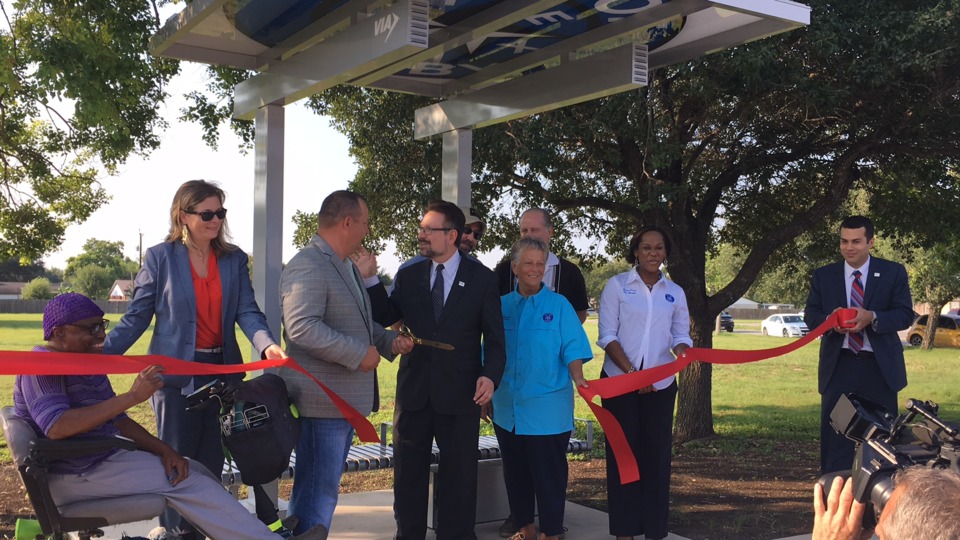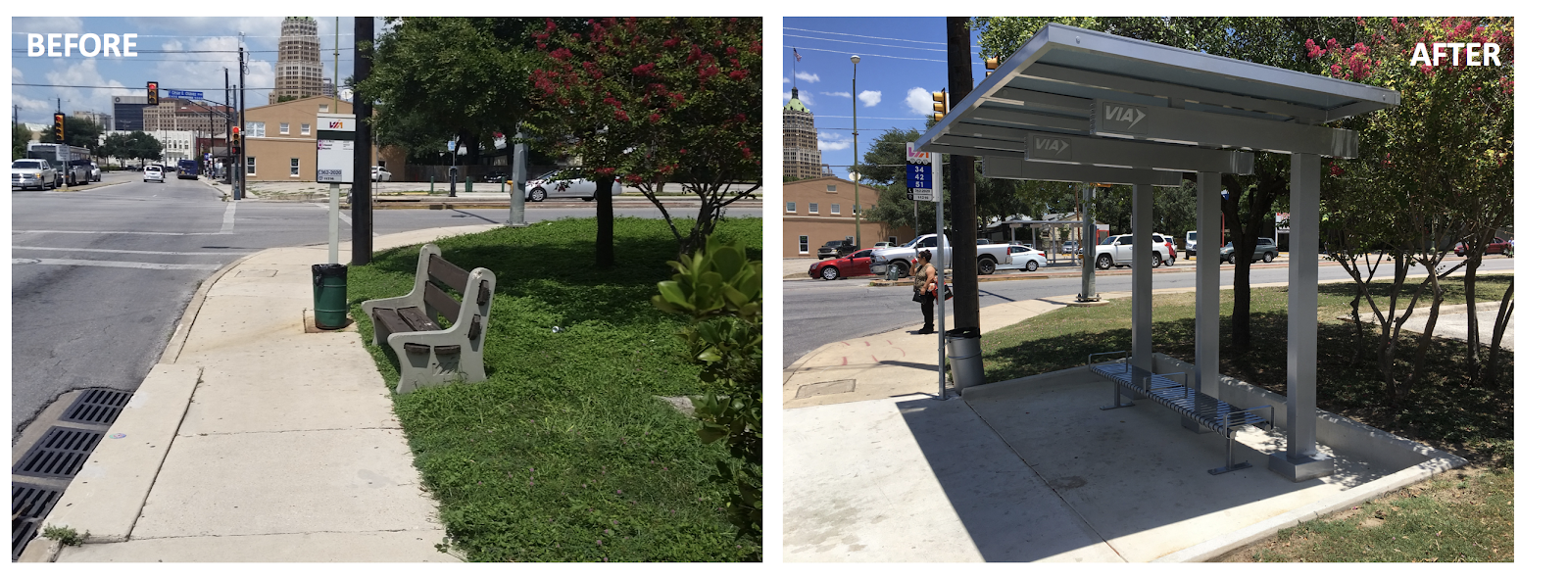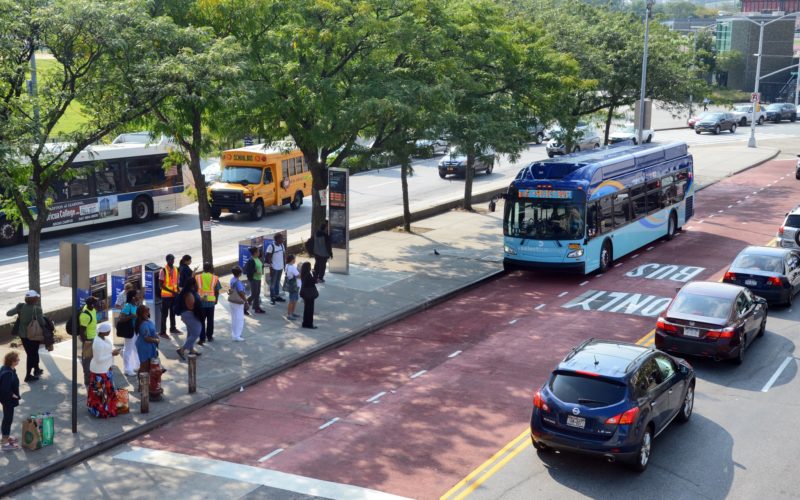
TransitCenter spoke with Abigail Kinnison Rodriguez (second from left), manager of passenger amenities at VIA, about the agency's lightning-fast implementation of accessible bus stops and shelters.
The easier it is for people to walk to transit, the more likely they are to use it. And yet, most transit agencies continue to spend more on park-and-rides than on pedestrian access to their bus stops.
Houston METRO recently spent over $16 million on a park-and-ride with 1,200 spaces – dwarfing the $4 million the agency spent to construct or refurbish 400 bus shelters. Houston currently has shelters at less than a quarter of its 9,000 bus stops. LA Metro recently spent $5.2 million on a 400-space park-and-ride, while 20% of its bus stops are still not ADA accessible.
VIA, San Antonio’s transit agency, is an exception.
In a precedent-setting commitment to bus stop upgrades, VIA installed sidewalk improvements and shelters at more than 1,000 stops between 2014 and 2017. With 2,300 total shelters systemwide, San Antonio bus riders now begin nearly 95% of their trips at an accessible stop with a shelter. No other American city of comparable size has made such comprehensive improvements to bus stops in such a short amount of time.
How did VIA do it?
The agency established its NextGen Shelter Program in 2011. At the time, many bus stops were just a pole in the ground, with no shelter to protect riders from the blazing Texas sun. Rider surveys consistently pointed to bus stop investments as a top desired transit improvement. In 2014, the VIA Board responded by budgeting $12 million to build 1,000 accessible stops and shelters in three years.
The lucky staff person tasked with coordinating 1,000 mini construction sites across San Antonio was Abigail Kinnison Rodriguez, manager of passenger amenities at VIA. She and her team of seven project staff and around 40 maintenance staff were responsible for site engineering and design, along with round-the-clock cleaning and maintenance of all stops and shelters. Because the VIA Board had committed to an ambitious goal, she says, her team was able to get the cooperation they needed from the city, property owners, contractors, and other partners.
To decide where stop improvements should be prioritized, Rodriguez and her team created guidelines with thresholds for ridership and wheelchair user activity. The highest-ridership stops without a shelter were the first priority for NextGen shelters, then high-ridership “ADA islands” — stops without sidewalk access or a shelter. The criteria included daily boardings, the number of daily boardings was one factor the team, team scored each stop with points given for daily boardings, but also added for proximity to schools, medical, grocery stores, community service centers, and other important destinations.
Rather than overdesign the site plans, Rodriguez’s staff created simple one-page templates. This enabled them to crank out designs on CAD software, adapt them to different contexts, share with other partners, and speed construction.
Throughout the process, Rodriguez and staff toured the city to let people know what the agency was planning. They shared shelter designs with riders and solicited feedback before committing to the new design. To communicate the importance of quality bus stops to the city officials and private property owners whose cooperation they needed, the VIA team used before-after pictures of bus stops and ridership data. Their message: “What if the 200 people using this stop drove instead? We’re trying to convince people to use transit, and they won’t if they don’t have a comfortable place to wait for a bus. A bus stop improvement is a community benefit.”
Close partnership with other public agencies was key to getting the shelters installed so quickly. Working with the city of San Antonio and Texas DOT, the team coordinated bus stop upgrades with other sidewalk improvements or roadway construction projects in the pipeline. Shelter foundations and ADA improvements were included and paid for within these roadway projects – VIA’s only expense was shelter installation once street and sidewalk construction was complete.


With 95% of VIA boardings now at accessible and sheltered stops, the pace of installing additional bus stop improvements has slowed as the agency’s priority shifts to maintaining the shelters and providing frequent service to these improved stops.
VIA’s NextGen bus shelter program should be model for other agencies. An accessible and safe walk to the bus should be a given for every transit rider, but these fundamental aspects of the transit experience remain too rare for too many people.
The major transit agencies in Los Angeles, Denver, Houston, Atlanta, Philadelphia and Washington DC all have fewer bus shelters than VIA, despite having much higher ridership. Rather than throw up its hands about the challenge of making bus stops sheltered and ADA-accessible, VIA allocated the money and empowered dedicated staff to make a difference at 1,000 stops (and counting). It’s well within the ability of other agencies to do this, and it’s past time to start making it a priority.
To learn more about bus stop programs across the country, be sure to check out TransitCenter’s latest report: From Sorry to Superb: Everything You Need to Know About Great Bus Stops.
 On the Brink: Will WMATA’s Progress Be Erased by 2024?
On the Brink: Will WMATA’s Progress Be Erased by 2024?
The experience of being a WMATA rider has substantially improved over the last 18 months, thanks to changes the agency has made like adding off-peak service and simplifying fares. Things are about to get even better with the launch of all-door boarding later this fall, overnight bus service on some lines starting in December, and an ambitious plan to redesign the Metrobus network. But all of this could go away by July 1, 2024.
Read More The Era of Bus Austerity is Over
The Era of Bus Austerity is Over
The Infrastructure Investment and Jobs Act–the “bipartisan infrastructure law” signed last year–offers limited relief when it comes to operating transit service. But the good news is that it represents a sea change when it comes to capital investment.
Read More